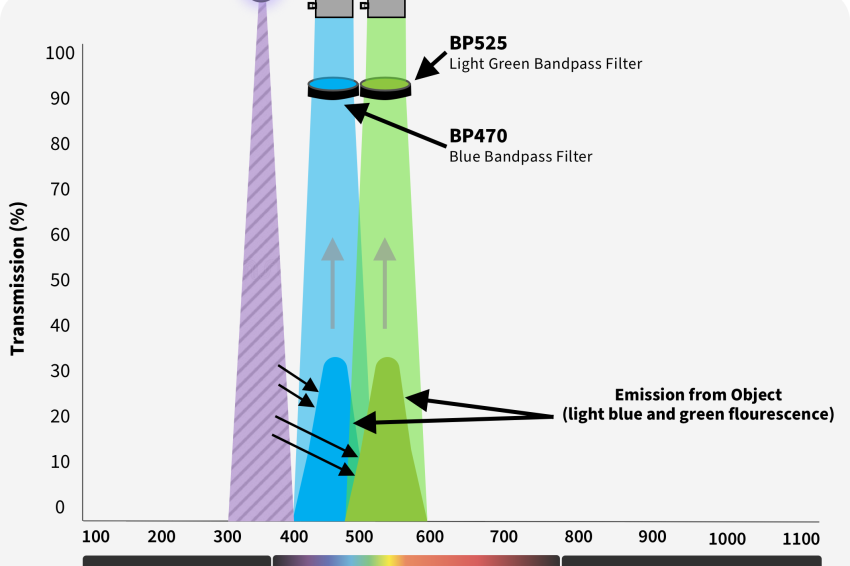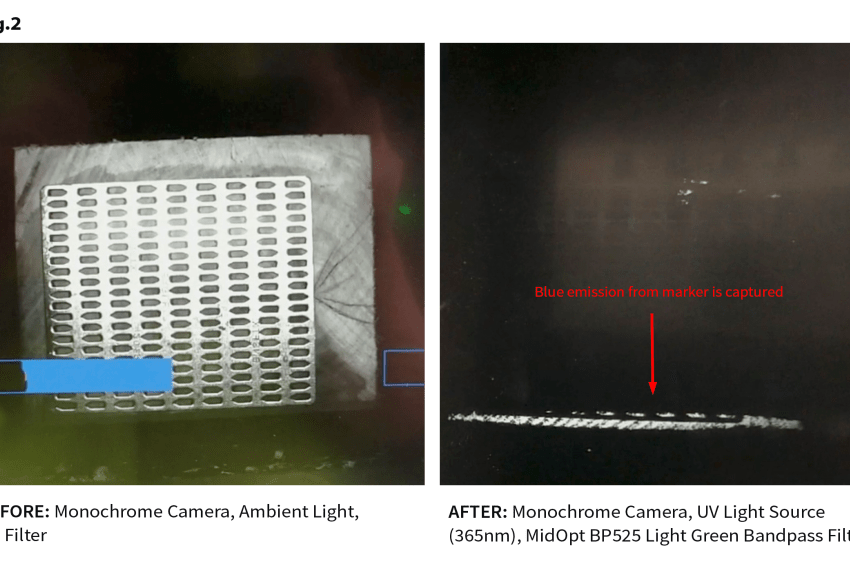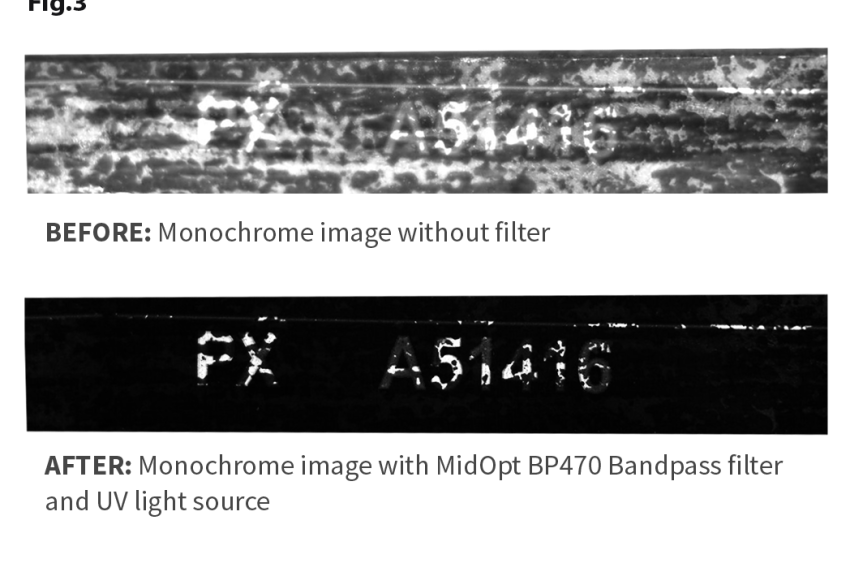Bandpass Filters Excel in UV Fluorescence Applications
Sap Side of Wood Used for Railroad Ties Is Detected by Bandpass Filters
Ultraviolet fluorescence applications, commonly utilized in life science, offer creative solutions in many industries, including industrial, railroad and consumer packaging. Product appearance heavily influences a consumer’s decision to purchase, so by printing a 2D matrix code in invisible ink, manufacturers can easily track and trace products without compromising product appeal. When a UV light source illuminates the UV ink, the UV energy is absorbed by phosphors. The phosphors become excited and convert the UV energy into visible light.
Deciphering Fluorescence
In machine vision systems, optical filters play an essential role in deciphering the fluorescence emission from the UV light source used for excitation, often overpowering the emission. The underlying technique is the same, whether the application is reading invisible ink or detecting oil or the presence of sap on a railroad tie.
MidOpt offers a variety of bandpass filters tailored for diverse applications in the ultraviolet, visible and near-infrared regions. For instance, when paired with UV LED lighting, in a fluorescence application the BP470 Blue Bandpass Filter helps users achieve stunningly bright, high-contrast images, making this filter a vital, leading component of machine vision UV fluorescence applications. For green LED lighting and UV fluorescence applications, the BP525 Light Green Bandpass Filter excels, providing higher peak transmission and better blocking of UV wavelengths than all-dichroic green bandpass filters.
Skye Gorter, CEO and Solution Lead for Skye Automation, is pleased with how the MidOpt BP525 and BP470 filters have performed within his UV fluorescence applications. He has been using the bandpass filters and other products for five years. He noted that the company’s staff has provided him with sound technical support from early on in his launching of his own company.
Detecting Sap Side Orientation for Railroad Ties
One of Gorter’s recent UV fluorescence applications has focused on detecting the sap side orientation of railroad ties for a railroad industry customer. ”The sap side refers to the outside of the tree, which, of course, would be the base product for the railroad tie,” he said. Determining this orientation is critical, because “when the railroad bed is made, if they put the sap side down, that part of the tree is less dense, so it will rot faster. So, they want to get this sap side of the tree out, away from the ground and get the center of the tree on the ground,” he noted.
”We use a multi-spectral approach for this project,” Gorter noted. When the ties have cracked and damaged ends, a fluorescent marker is used to mark the sap side of the ties before metal end plates are embedded into the wood to strengthen them. But the metal plates often obscure the fluorescent marks, leaving ‘just small holes’ to view those through, he said. ”We needed to get better contrast between the fluorescent paint marker and the steel plate,” he added.
In that scenario, using appropriate filters, paired with UV lighting makes all the difference. ”We are using monochrome cameras with red bandpass filters on two of the cameras. And then we use a third camera with a green BP525 bandpass filter for a UV lighting application,” Gorter said.
Another aspect of this project uses this setup to examine the growth rings of the raw tree that’s ‘shaped into the railroad tie’ to identify its projected center, Gorter explained. When a railroad tie with an endplate “runs through our inspection system, we use the UV light with a bandpass filter to ignore the highly-reflective end-plate and pick up on the fluorescent paint mark only,even if the marking is minimal,” Gorter said. ”We then correlate the position of the paint mark to the position of the railroad tie to determine the correct sap side of the tie,” he added.
Gorter experimented with different filters from a Midopt Test Kit before settling on the BP525 filter. ”I tried a few different ones to see which ones gave me the best contrast,” he explained.
Validating an Approach for Detecting Tape on a Building Product
Gorter has also been using the BP470 Filter to test and validate an approach for a UV fluorescence application involving building products. A release tape is affixed to the back side of the product, and it has numbers and letters printed on it to help users determine if it’s in the correct orientation or upside down, Gorter explained. That tape is designed to prevent the product from sticking to itself and it needs to be removed before the product is installed.
Gorter compared the results he obtained by pairing the filter with a UV light to detect the tape to the results the customer obtained using a different system. Using the other system for release tape detection, “they just get this white blob,” he said. But within his setup that employs the MidOpt BP470 Filter, he can detect whether the tape is “right side up or upside down.” (Fig.3)
Furthermore, Gorter’s setup “eliminates, really, most of the background and differentiates the lettering to a degree,” he said. It even shows – through light and dark contrast – where the tape has adhered well to the building product and where it hasn’t.
Considering New Applications?
When Gorter is pondering a new application, he uses a systematic process. “The first step I typically take is evaluating whether it’s going to be an area scan or line scan system. And then it is determining what the goal of the project is, what type of cycle rates we need or exposure times are necessary and how the environment is going to influence our lighting and opto-mechanical setup,” Gorter said.
He noted that he’s drawn to continue using MidOpt Bandpass Filters and other products because “they’re reliable, they deliver quickly, and the excellent technical support provided is consistent and reliable.”
Author
Barry Warzak, Founder
Contact
Midwest Optical Systems, Inc.
322 Woodwark Lane
60067 Palatine
IL, United States
+1 847359 3550
+1 847 359 3567









